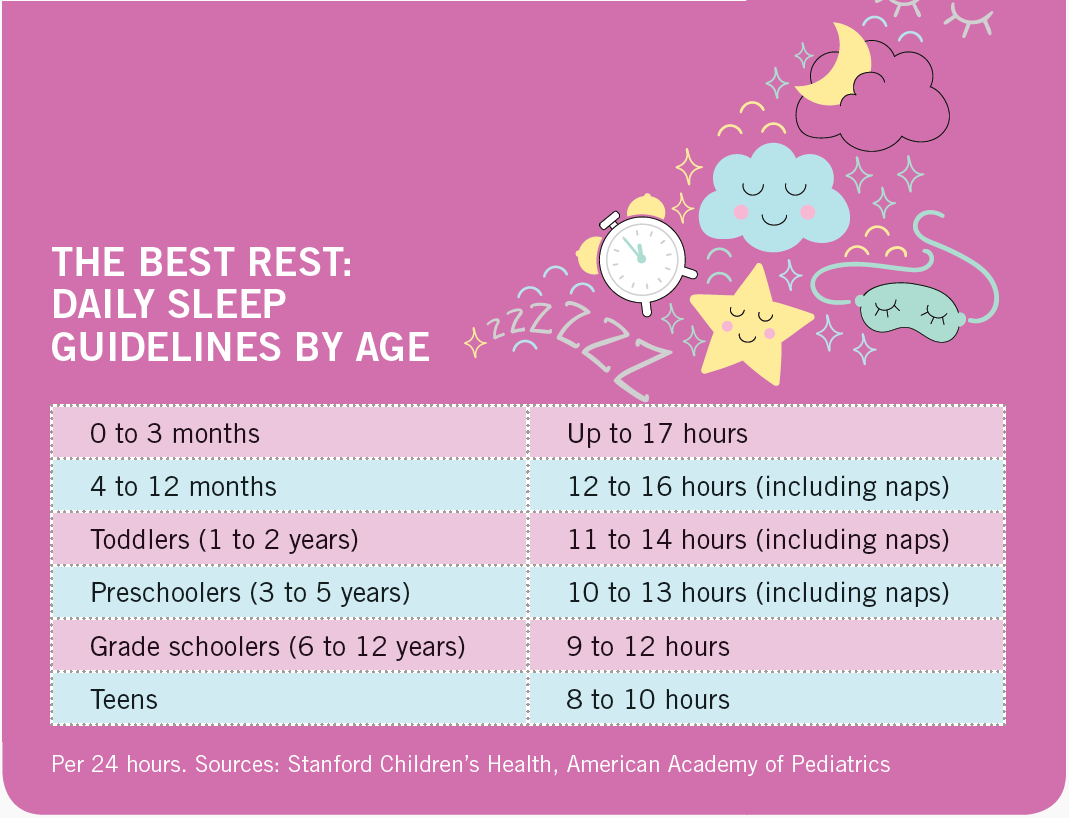Eye-opening truths about kids and the effects of too little shut-eye.
The baby who wakes you at 3 a.m. The nap-resistant toddler. The teen who texts deep into the night, then sleeps too late in the morning.
For many parents, concerns about when a child should and should not be sleeping begin at birth and don’t end until the child is out of the house—and for good reason.
“Sleep is the glue that holds us together,” says pediatric sleep physician and pediatric pulmonologist Stephanie Zandieh, MD, Director of Pediatric Sleep Medicine at Saint Barnabas Medical Center and a member of RWJBarnabas Health medical group. “Lack of sleep contributes to difficulties with learning, memory and emotional control, and causes disruptive behavior, decreased energy and lack of motivation.”
So how can you help write a better bedtime story for your child?
THE EARLY YEARS: BABIES AND TODDLERS
Newborns don’t enter the world with an internal clock. “Before 3 months of age, baby doesn’t know the difference between day and night,” says Dr. Zandieh. “Once they are about 3 months old, you can teach baby to self-soothe and fall asleep without parental presence, and keep to a schedule.”
Most babies will take a morning nap and an afternoon nap. Between 1 and 2 years old, the morning nap gradually gets later and becomes the only nap. Since naptime often becomes a battle of wills, how does a parent know when to insist? Dr. Zandieh offers a guideline base d on your child’s behavior: “If a child is 3 years old and doesn’t nap and is a wreck the whole day, then that child still needs a nap.”
Having an established sleep routine at night (for example, taking a bath, brushing teeth and reading a book) helps signal the brain that there is about to be a shift to sleep.
LATER ON: TWEENS AND TEENS
By the teenage years, most kids have evolved from larks (showing a preference for waking early and going to bed early) to owls (staying up later and wanting to sleep later). A “perfect storm” of sleep-disturbing factors takes place in these years, Dr. Zandieh points out: School starts earlier, kids go to bed later, and electronics in the bedroom detract from sleep.
Uneven schedules play a role. Teens sleep in on weekends, stay up even later on weekend nights and create a bad cycle of morning sluggishness for the beginning of the new school week.
To compensate, many teens go back to taking a nap. “Napping c an be good if it’s 20 to 40 minutes and if it’ s sporadic,” says Dr. Zandieh, “but many teens nap after school and then have trouble going to sleep at night.” She recommends no more than two hours’ difference between weekend and weekday bedtimes.
Another problem endemic to this age group: Teens do everything in their bedrooms, including homework, phone calls and social media. “This becomes bad for sleeping,” says Dr. Zandieh. “They subconsciously associate the stresses of life with bed, as opposed to looking at bed as a place for sleep and comfort.”
Regardless of age, Dr. Zandieh offers these suggestions for setting the stage for a good night’s sleep.
- Keep the bedroom cool (at a temperature less than 75 degrees), comfortable and quiet.
- Block out as much light as possible.
- Keep electronics out of the room and keep pets out of the bed.
COULD IT BE A SLEEP DISORDER?
If your child’s sleep-related behavior is troubling, a sleep disorder is a possibility.
“We classify something as a sleep disorder when a lack of sleep seeps into daytime behavior or activities,” says Dr. Zandieh. “If you have a child who is snoring three or more days a week, or who is exhibiting daytime sleepiness or difficulties in school, speak to your pediatrician or see a sleep doctor.”
Diagnosis of a sleep disorder begins with a thorough history and physical exam. For babies and younger kids, keeping a sleep log can be helpful. For teens, Dr. Zandieh suggests a wrist recorder or smartwatch to track this information.
The most common childhood sleep disorders include:
- Obstructive sleep apnea, marked by snoring and feeling tired even after a full night’s sleep.
- Insomnia, which causes trouble falling asleep and/or staying asleep.
- Hypersomnia, which causes excessive sleepiness.
- Parasomnia (sleepwalking or sleeptalking).
- Rhythmic body movements. The most common among these is restless leg syndrome, which causes a creepy-crawly feeling in the legs, often mistaken for growing pains.
- Secondary nocturnal enuresis, a form of bedwetting that develops six months or more after a child has learned to control his or her bladder.
- Delayed sleep phase syndrome, in which sleep is delayed by two or more hours beyond bedtime and thereby causes difficulty waking.
When necessary, Dr. Zandieh will order a sleep study. The Center for Sleep Disorders at Saint Barnabas Medical Center is equipped for children of all ages, including those with special needs. Each room is private (a parent stays with the child) and comfortable. Noninvasive monitors track brain activity, breathing, airway pressure, heart rate and more, to diagnose any disorder and inform treatment plans.
We have taken every precaution for the safety of our patients and team members. To learn more about the Center for Sleep Disorders at Saint Barnabas Medical Center, call 973.322.9800 or visit www.rwjbh.org/sbmcsleep